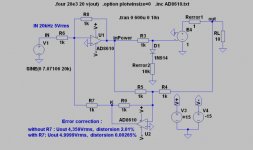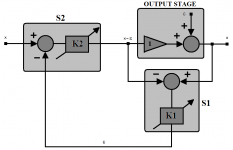ingrast said:
It has been customary to assume plant gain as unity (eg emitter follower etc.) but in fact the concept is valid for arbitrary gain plants.
Conceptually what we seek is to compare the plant input with a correspondingly scaled output, and here is where 1/A' enters.
If you check the gain expression and for a moment asume 1/S -B =0, then system gain is given *exactly* by A'.
Rodolfo
PS. It makes sense to make A'=Ao where Ao is for example the nominal plant gain, but this condition is not necessary for the system to work, it self adjusts to set total gain to A'.
I find it essential when examining a circuit never to get bogged down in the orthodox minutia of a discipline (in this case Control) until a vivid appreciation of its first-order workings is understood.
Keep it simple: the (1/A') term appears unnecessary, as it has no equivalent in the circuit or its design philosophy.
I remain unconvinced with your assertion here that a virtually complete cancellation (for practical purposes) of error is unachievable: Mr Cordell has provided a comprehensive demonstration to the contrary.
mikeks said:
.......
Keep it simple: the (1/A') term appears unnecessary, as it has no equivalent in the circuit or its design philosophy.
It is as much unnecessary as the feedback factor B in a conventional negative feeback scheme.
It sets system gain.
Rodolfo
ingrast said:
......It sets system gain.
Rodolfo
Not really, Rodolfo.
You require a nominal unity gain (plus inversion) across summers S1 and S2 in order to cancel error in the output stage.
mikeks said:
... until a vivid appreciation of its first-order workings is understood.
....
A vivid appreciation is not very difficult anyway.
Assume for a moment A'=Ao, where Ao is a constant (eg. nominal, real amplifier gain).
Under this conditions, output of S2 will be exactly the error introduced by A because of its departure from linearity and gain/phase deviations with frequency. Of course we are talking of error scaled to the amplifier input level range.
Assuming the input node S1 is equally perfect and of unity gain (S=1), and setting the correction factor B=1, then what we have as input to the amplifier is the intended input signal Vin plus a correction term exactly opposite to the error introduced by the amplifier (difference between A and Ao).
On the other hand, if A' is other value different from Ao, then the output of S2 will be the "genuine" error plus a clean scaled copy of the desired signal. This copy when reinjected through S1 makes for the gain difference between Ao and A', restoring system gain to A'.
Rodolfo
mikeks said:
Not really, Rodolfo.
.....
Kindly Mike, please check the equations [edit] derivation, it is not relly involved.
Rodolfo
ingrast said:
Kindly Mike, please check the equations.
Rodolfo
Hi Rodolfo,
I have checked your equations, which are correct if one accepts that the presence of the (1/A') term is vital to the model.
mikeks said:
Hi Rodolfo,
I have checked your equations, which are correct if one accepts that the presence of the (1/A') term is vital to the model.
Good.
the term 1/A' is not vital to the model, but is convenient in the sense it makes it more general than restricting it to unity.
Perhaps much more important, it allows for a moderate voltage gain in A, which in turn allows for a lower drive level more compatible with high performance front end implementation.
I have not only simulated but built and tested amplfiers (there are some more and vital considerations to account), with results coincident with predictions. This work is what is detailed in the draft currently in the JAES pipeline.
Rodolfo
Hi Rodolfo,
I look forward to reading it. Any info on when it will be published?
You might consider looking at Lipshitz/Vanderkooy (''Is Zero Distortion
Possible With Feedback?'', AES Preprint #2170, Oct.1984: fig. 1d).
Mike
I look forward to reading it. Any info on when it will be published?
You might consider looking at Lipshitz/Vanderkooy (''Is Zero Distortion
Possible With Feedback?'', AES Preprint #2170, Oct.1984: fig. 1d).
Mike
mikeks said:Hi Rodolfo,
I look forward to reading it. Any info on when it will be published?
You might consider looking at Lipshitz/Vanderkooy (''Is Zero Distortion
Possible With Feedback?'', AES Preprint #2170, Oct.1984: fig. 1d).
Mike
I was advised it should take 3 - 4 months for the review process, and it is still to be seen whether it will be accepted for publication.
As for the Lipshitz/Vanderkooy paper, I was advised also by Bob to check it. Do you have an electronic copy? I should greatly appreciate it, my mailing address is ingrast@adinet.com.uy.
Thanks in advance.
Rodolfo
powerbecker said:Hello,
a bit tiresome the theoretical reflection, here a try bare any mathematics...worked though 🙂
Regards
Heinz!
Thanks Heinz
Elegantly simple demonstration of the need for unity loop gain across the summers if error cancellation is to occur.
Excellent!

Just post the zipped schematic and op amp models. Cheers
Re: Ultimately:
Could not K2 be omitted inside the S2 box since the S2 summing point is actually only a resistor which is perfectly linear?
Cheers Michael
mikeks said:The following, with non-ideal summers included, is my preferred understanding of error correction as described by Robert Cordell:
Could not K2 be omitted inside the S2 box since the S2 summing point is actually only a resistor which is perfectly linear?
Cheers Michael
A positive feedback loop is equivalent mathmatically to a gain. There is no argument possible. So why debate it? Why add all this noise, Mike?
Wouldn't it be more useful to discuss the pros and cons of implementing a gain block using a positive feedback loop instead of an amplifing device?
Wouldn't it be more useful to discuss the pros and cons of implementing a gain block using a positive feedback loop instead of an amplifing device?
mikeks said:On reflection, Heinz, i think your results are not reproducible, unless i am doing something wrong, or using an inferior model?
Check it out:
Sorry to all, Mike , you are right!
Distorsion go down from 2% to only 0.026%!
That is "only" about 75 times less.
My mistake was wrong reading

Regards
Heinz!
- Home
- Amplifiers
- Solid State
- Bob Cordell Interview: Error Correction

